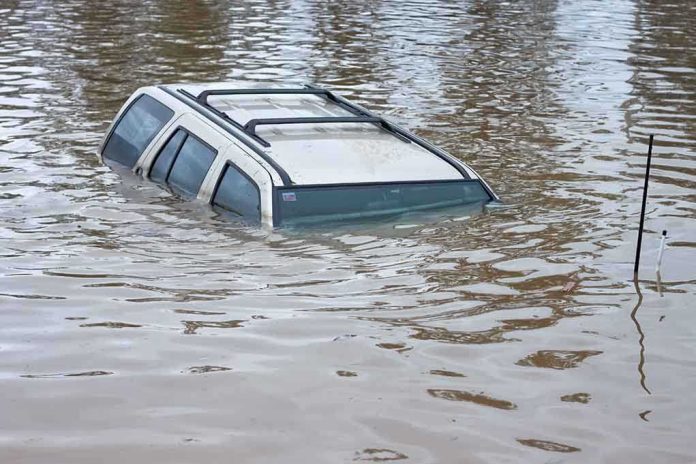
Flood victims in Texas are finding more hope in the hands of Samaritan’s Purse than in the waiting rooms of FEMA, leaving taxpayers once again wondering why bureaucratic agencies can’t keep up with faith-based volunteers on the front lines.
At a Glance
- Samaritan’s Purse delivers immediate aid to Texas flood victims as FEMA response faces scrutiny
- President Trump’s disaster declaration activates federal resources, but many locals see little benefit
- Public frustration grows over FEMA’s bureaucracy, slow pace, and leadership questions
- Community groups and volunteers fill gaps left by federal agencies, spotlighting government inefficiency
Private Compassion Outpaces Federal Bureaucracy in Texas Floods
Texans devastated by the July floods are discovering that help comes faster from community volunteers than from federal disaster agencies. Samaritan’s Purse, a faith-based relief group, rolled into the hardest-hit neighborhoods with boots on the ground, tools in hand, and real answers for desperate families. While FEMA teams scrambled to coordinate, the volunteers were already clearing debris, delivering food, and offering shelter. Residents repeatedly voiced gratitude for these volunteers, contrasting the hands-on help with the frustrating delays and paperwork demanded by federal agencies. The response gap was so obvious that even local officials began directing people toward church basements and volunteer tents instead of FEMA’s disaster recovery centers.
FEMA, despite its vast budget and national mandate, continues to struggle with what should be a straightforward mission: help Americans in crisis. In Texas, the agency’s much-hyped surge capacity—over 4,000 reservists and specialized teams—was hampered by red tape and a leadership shakeup. With Cameron Hamilton, a former Navy SEAL with no disaster management experience, now serving as interim director, the agency appeared more focused on internal reviews and procedural compliance than on delivering direct aid. This disconnect has not gone unnoticed by the very people FEMA is supposed to serve. Many residents say the agency’s presence is limited to distributing forms and promising future assistance, while the real heavy lifting is done by private organizations and local volunteers.
Leadership Turmoil and Political Baggage Compound FEMA’s Struggles
The operational chaos at FEMA has only grown since President Trump ordered a comprehensive review of the agency’s structure, citing longstanding concerns about inefficiency, political bias, and “mission drift.” Critics argue that FEMA has lost sight of its original mandate, becoming just another bloated bureaucracy more interested in optics than outcomes. Past disasters, from Katrina to Hurricane Andrew, exposed the agency’s chronic flaws, and this year’s floods in Texas are no different. The appointment of an untested interim director has further eroded confidence among both lawmakers and disaster survivors. Calls to restructure or even phase out FEMA entirely have intensified, though resistance from entrenched interests in Congress means meaningful reform remains an uphill battle.
While the White House touts its activation of federal resources, the boots-on-the-ground reality is far less reassuring. For families standing knee-deep in waterlogged memories, the difference between a neighbor’s helping hand and a FEMA official’s clipboard couldn’t be starker. The agency’s defenders point to the complexity of coordinating multi-state responses and the importance of federal oversight, but critics counter that real-world needs demand speed, flexibility, and accountability—qualities in short supply at FEMA headquarters.
Local Organizations Step Up as Federal Response Falters
As the floodwaters receded, it became clear who was truly leading the recovery: local churches, volunteer fire departments, and national nonprofits like Samaritan’s Purse. These groups mobilized in hours—not days—delivering everything from hot meals to temporary housing. Their efforts were not just faster but also more personal, rebuilding community trust even as faith in government agencies waned. For many Texans, this experience was a wake-up call, reinforcing the value of self-reliance, neighborly compassion, and the enduring strength of local institutions. The story unfolding in Texas is not just about flood recovery—it’s about the ongoing debate over who Americans can really count on when disaster strikes.
Congressional leaders, meanwhile, remain locked in debates over the future of FEMA, with some advocating for a return to state-led disaster management, and others warning that dismantling the agency could leave vulnerable communities at risk. Yet, for those still drying out their homes, these political battles are academic. What matters is who shows up, who brings real relief, and who understands that government’s first job is to serve its own citizens—not to get lost in a maze of red tape and excuses.
Sources:
FEMA Activates in Texas Following President Trump’s Major Disaster Declaration
Presidential Order: Council to Assess the Federal Emergency Management Agency
Brookings: Will the Federal Government Be Ready for Natural Disasters This Year?














